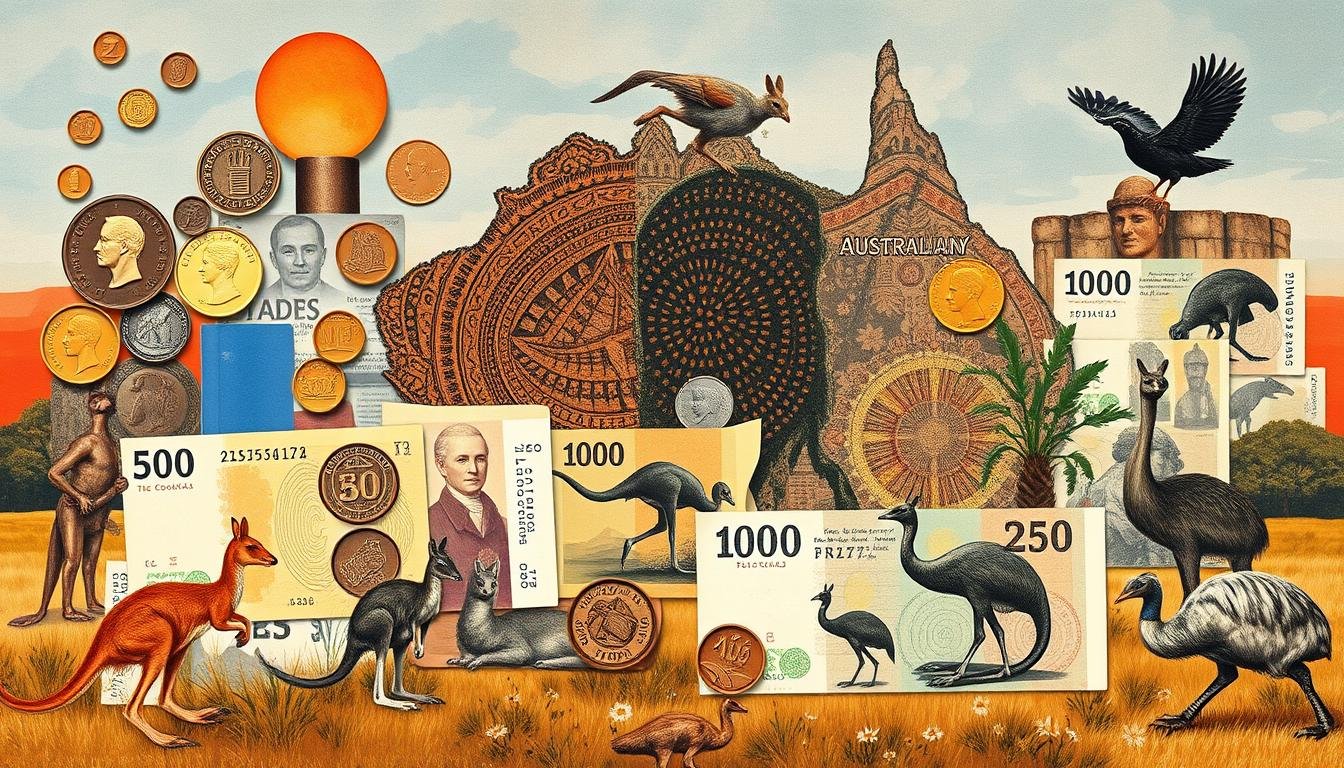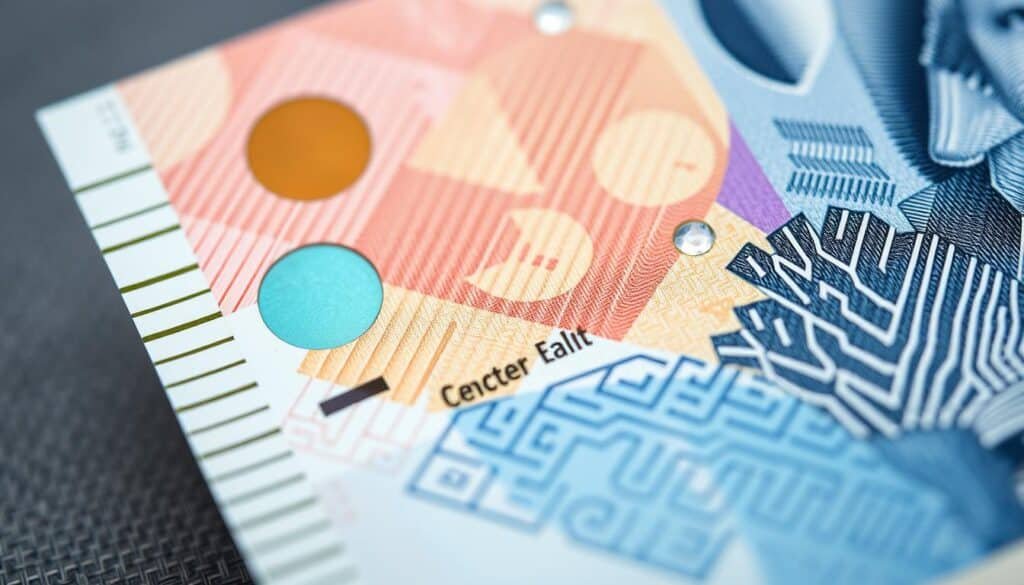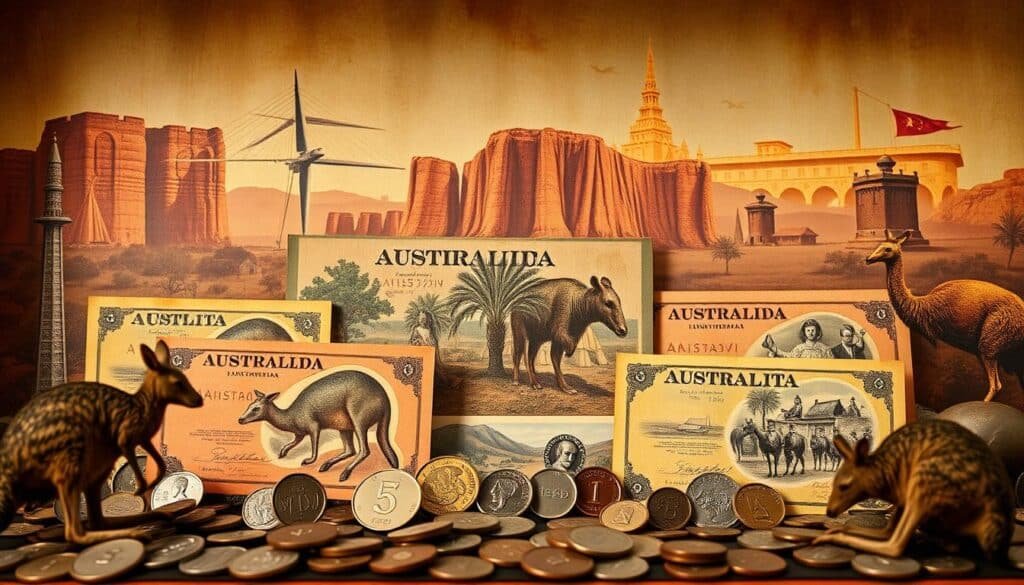
Exploring the history of Australia’s currency reveals a journey from its first European settlement in Port Jackson, New South Wales, on 26 January 17881. This event marked the start of a complex monetary system. The evolution of Australia’s currency is a tale of adaptation and innovation, mirroring the country’s growth and its integration into the global economy. A significant milestone was the introduction of the Australian dollar as a decimal currency on 14 February 19662. The history of Australia’s currency is rich and varied, from early trade systems to the modern Australian dollar. Various forms of currency have been used, including British silver and copper coins, Australian minted sovereigns, and private bank notes1.
The history of Australia’s currency is a captivating subject that highlights the country’s development and its role in the global economy. The Australian dollar is ranked as the sixth most-traded currency in the foreign exchange market as of April 20222. As you explore the evolution of Australia’s currency, you will discover the factors that have shaped its monetary system. These include the introduction of sterling coinage, the establishment of the Commonwealth Bank, and the transition to decimal currency12.
Key Takeaways
- The first European settlement of Australia took place in Port Jackson, New South Wales, on 26 January 17881.
- The Australian dollar was introduced as a decimal currency on 14 February 19662.
- The Australian currency has undergone significant changes throughout its history, including the introduction of sterling coinage and the establishment of the Commonwealth Bank1.
- The country’s monetary system has been shaped by various factors, including the transition to decimal currency and the introduction of the Australian dollar2.
- The history of australia’s currency is a rich and complex topic that showcases the country’s development and its place in the global economy12.
Aboriginal Trade Systems: Australia’s First Forms of Currency
Delving into Australia’s currency history, it’s vital to acknowledge the Aboriginal trade systems pre-dating European arrival. These systems, documented in the currency in australia timeline, utilized items like tools, food, ochres, shells, and raw materials3. This bartering system, lasting tens of thousands of years, was fundamental to the australian dollar history.
The Aboriginal trade systems were intricately woven with a network of exchange and reciprocity. Unlike the australian coinage development seen later, these early systems were foundational for the evolution of more sophisticated currency systems4. Traded items included:
- Tools, such as stone knives and spearheads
- Food, such as fish and other seafood
- Ochres, used for ceremonial and artistic purposes
- Shells, used for decoration and as a form of currency
The cultural importance of these early trade practices cannot be overstated. The currency in australia timeline highlights their critical role in shaping the australian dollar history and australian coinage development5. As you further explore Australia’s currency history, you’ll observe how these initial trade systems influenced the advent of more advanced currency systems.
Colonial Currency Crisis: Early European Settlement Period
The history of Australian banknotes is a captivating tale that started with the early European settlement of Australia. As you dive into the currency changes in Australia, you’ll find that the British sent the First Fleet to Australia in 1788 to establish a penal colony. Yet, they didn’t bring much money6. This led to a reliance on foreign coins and bartering, causing significant economic hurdles. The absence of a formal currency system hindered the colonists’ ability to trade and conduct commerce.
The European population expanded rapidly, reaching 4,221 by December 1792, with 3,099 of them being convicts6. The economy mainly thrived on agriculture, with settlers granted land to purchase up to 4,000 acres6. The establishment of the Bank of Australasia in 1835 and the Union Bank of Australia in 1837 marked a significant financial milestone for the colonies6.
The currency changes in Australia during this era were profound, introducing the first Australian-made currency. The history of Australian banknotes is a testament to innovation and resilience, as the colonists found ways to navigate through economic challenges. As you further explore the history of Australian currency, you’ll see how the country developed a unique and robust monetary system.
The early European settlement period saw considerable economic growth, with the Australian GDP per worker increasing at a rate about twice that of the US and three times that of Britain6. Yet, the economy faced fluctuations, with two major economic depressions occurring in the 1840s and 1890s6. The discovery of gold in Victoria in 1851 helped alleviate these depressions and boost economic growth6.
The Establishment of the First Australian Mint
Delving into australian monetary history, you’ll find the first mint’s establishment was key. It stabilized currency, boosted trade, and fueled economic growth. This milestone was vital for minting gold sovereigns and other coins, deeply affecting the colonial economy7.
The Sydney Mint, opened in 1855, was Australia’s first official mint7. It started Australian minting, producing gold coins and other denominations. The mid-19th century gold discoveries raised coinage demand, leading to more gold coins7. This era was critical in the australian dollar history, as the nation moved from foreign to its own currency.
The Sydney Mint’s creation profoundly influenced the colonial economy. It allowed for coins tailored to Australia’s needs. As you explore australian monetary history, you’ll see this was a key step towards a stable, independent currency system. The introduction of the Australian Pound in 1910, replacing various state currencies and pegged to the British Pound, further solidified the country’s monetary framework7.
In conclusion, the first Australian mint’s establishment was a major economic milestone. It set the stage for a strong, independent currency system. As you continue to explore the australian monetary history, you’ll learn more about the Australian dollar’s evolution and its economic impact8.
The History of Australia’s Currency: From British Pounds to Australian Pounds
Exploring the history of australia’s currency reveals the introduction of the Australian pound in 1910, pegged at par with the pound sterling9. This move marked a significant shift towards a national currency, setting it apart from the British pound. The australian currency evolution was a critical step towards the country’s growing independence. It highlighted the need for a currency tailored to its unique economic needs.
The introduction of the Australian pound was a landmark in the country’s economic development. Before this, various banks, such as the Bank of New South Wales, the Bank of Australasia, and the Union Bank of Australia, were established in the 19th century9. The Australian pound’s adoption replaced the British pound, profoundly impacting the country’s economy.
The transition to the Australian pound was a significant event in the history of australia’s currency. The Australian government’s role in this transition was instrumental. The introduction of the Australian pound was a major step towards the country’s economic independence. The australian currency evolution continued with the introduction of the Australian dollar in 1966, which replaced the Australian pound10.
Today, the Australian dollar is among the most traded currencies globally. The history of australia’s currency is a captivating narrative that mirrors the country’s growing independence. It reflects the need for a currency that meets its unique economic requirements. The australian currency evolution showcases the country’s economic development and its adaptability to changing economic landscapes.
The Australian government has remained vital in the australian currency evolution, with the Reserve Bank of Australia managing monetary policy9. The introduction of the Australian dollar in 1966 was a significant milestone in the country’s economic journey. It has had a lasting impact on the country’s economy.
Decimal Currency Introduction: The Dawn of Dollars and Cents
The introduction of decimal currency in Australia marked a major milestone in the nation’s economic journey. As part of the currency in australia timeline, the government announced the shift to decimal currency for 196611. This move aimed to streamline financial operations, boosting efficiency in both industry and commerce11.
The transition required a public awareness campaign and the resolution of several implementation hurdles. Key aspects of the decimal currency introduction include:
- The changeover to decimal currency was set for February 196611.
- The new currency unit, the dollar, was pegged at 10 shillings in the old system11.
- The adoption of the decimal system was forecasted to save the Australian economy over £11 million yearly12.
The australian coinage development was integral to the decimal currency introduction. Stuart Devlin’s design introduced coins of 1, 2, 5, 10, 20, and 50 cents11. The successful launch of the Australian dollar ushered in a new chapter, simplifying transactions and aligning with global decimal standards12.
Evolution of Australian Banknote Security Features
The history of Australian banknotes has seen significant advancements in security features to combat counterfeiting. The introduction of polymer banknotes in 1998 was a major leap forward13. This innovation has been key in safeguarding the currency and bolstering public trust. The continuous evolution of security features is evident, with updates aimed at outsmarting counterfeiters.
Microprinting and transparent windows with diffractive optically variable devices (DOVDs) are notable security measures14. The $5 polymer note, launched in 1992, was the first in a polymer series, featuring a DOVD image of Captain James Cook13. The design of the $5 note was refreshed in 1995, and a new version with tactile features was introduced on 1 September 201613.
The Reserve Bank of Australia reports that there are approximately 1.3 billion Australian banknotes in circulation, valued at around $61 billion14. The shift to plastic banknotes in the mid-1990s has greatly reduced counterfeiting rates. Advanced security features, including microprinting, have made it increasingly challenging for counterfeiters to produce high-quality fake banknotes14.

The evolution of Australian banknote security features showcases the country’s dedication to currency integrity. The history of Australian banknotes reveals a continuous effort to enhance security features, keeping pace with counterfeiting tactics. The 2016 series of banknotes introduced advanced security features, such as a top-to-bottom window and microprinting13. The $100 note, updated in 2020, retains a polymer design with sophisticated security elements, including a transparent window and microprinting13.
Key security features of Australian banknotes include:
- Microprinting: a highly precise printing technique that is difficult for counterfeiters to reproduce14
- Transparent windows: feature a diffractive optically variable device (DOVD) that creates a hologram-like effect13
- Tactile features: raised printing that can be felt by touch, making it easier for people with vision impairments to identify the denomination13
For more information on the history of Australian banknotes and currency changes in Australia, visit the Reserve Bank of Australia’s website. The evolution of polymer banknotes and their impact on Australian currency history is a compelling topic. It highlights Australia’s commitment to currency integrity and counterfeiting prevention13.
Australian Coinage Design Changes Through the Ages
Australia’s coinage has seen significant transformations, mirroring the nation’s history, culture, and values. The australian coinage development has been influenced by the introduction of new coins and updates to existing designs. For instance, the Cartwheel penny in 1800 initiated a standardized monetary system15. The australian dollar history also highlights the introduction of the Australian pound, shilling, and pence system in 191016.
Design changes include the addition of indigenous motifs, updates to royal portraits, and commemorative editions. These elements have enriched Australian currency, playing a key role in the australian coinage development. The 1984 introduction of the one-dollar coin with a mob of five kangaroos is a notable example15. The 1988 release of the $2 coin with a bi-metallic composition further showcases the australian dollar history16.
Here are some key milestones in the australian coinage development:
- Introduction of the Cartwheel penny in 180015
- Introduction of the Australian pound, shilling, and pence system in 191016
- Introduction of the one-dollar coin featuring a mob of five kangaroos in 198415
- Introduction of the $2 coin with a bi-metallic composition in 198816
| Year | Event | Description |
|---|---|---|
| 1800 | Introduction of the Cartwheel penny | Marked the beginning of a standardized monetary system15 |
| 1910 | Introduction of the Australian pound, shilling, and pence system | Created a unified currency across the six colonies16 |
| 1984 | Introduction of the one-dollar coin | Featured a mob of five kangaroos15 |
| 1988 | Introduction of the $2 coin | Featured a bi-metallic composition16 |
Polymer Innovation: Australia’s Revolutionary Banking Technology
Australia has led in banking technology, introducing polymer banknotes that have greatly influenced australian monetary history. The journey to polymer banknotes started in 1968 and took 21 years to debut17. This innovation has boosted the security and durability of Australian banknotes. It has also spurred global currency advancements, leading to notable currency changes in australia.
The advent of polymer banknotes in Australia was a global first17. The first polymer banknote, a $10 note, was released in 1988 for the Bicentennial17. By 1998, all notes were polymer, replacing paper ones17. This shift has enhanced durability and security, significantly reducing counterfeiting rates. Before polymer, the $10 note saw 400 ppm counterfeiting18.
Development Process
The creation of polymer banknotes required substantial investment and research. In 1987, the Reserve Bank of Australia (RBA) paid A$8 million to the CSIRO for polymer technology rights18. The RBA sold 850,000 commemorative packs of the first polymer note for A$14 each, earning over A$11.9 million18.
Global Impact
Polymer banknotes have made a significant global mark, with many countries adopting them. By 2009, Securency International Pty Ltd was exporting to 25 countries17. Over three billion polymer notes were in circulation by 200917. This technology has saved more than $20 million annually, thanks to longer lifespans and lower production costs17.
| Year | Event | Impact |
|---|---|---|
| 1968 | Development of polymer notes began | Significant investment in research and development |
| 1987 | RBA paid A$8 million to CSIRO for polymer banknote technology | Acquisition of rights and technology for polymer banknote development |
| 1988 | Introduction of polymer banknotes in Australia | World’s first implementation of polymer banknote technology |
Digital Transformation of Australian Currency
The history of Australia’s currency is undergoing a significant transformation with the advent of digital payment systems and the introduction of a central bank digital currency (CBDC)19. As technology advances, the way Australians interact with their currency will change dramatically. This shift promises new conveniences, efficiencies, and enhanced security. The evolution of the Australian currency is driven by the increasing demand for digital payments, with India’s digital economy expected to hit US$1 trillion by 202819.
The growth of digital payments in Australia is also influenced by the country’s fintech sector. Australian investors have poured over US$2 billion into India’s fintech ecosystem19. The Victorian government has launched initiatives to boost the state’s productivity and economic recovery, focusing on SMEs hit hard by the pandemic20. The Digital Futures program aims to enhance Victoria’s productivity and economic recovery, with a special focus on SMEs affected by the pandemic20.
The digital transformation of Australian currency will likely have a profound impact on the country’s economy and financial systems. The introduction of a CBDC could make transactions more efficient and secure, potentially reducing financial crime risks19. The ongoing evolution of the Australian currency is a critical area to monitor, as it shapes the future of digital payments in the country.
International Influence of Australian Currency Innovations
Australia’s innovative approach to currency has significantly influenced the global financial scene. The australian dollar history showcases the nation’s dedication to currency technology advancements. The introduction of polymer banknotes, for instance, has been embraced by nations worldwide21.
The global acceptance of polymer notes stems from their enhanced durability and security features. The australian coinage development has also been instrumental in shaping the country’s currency. The incorporation of advanced security technologies has established a new benchmark for currency production globally22.
Some key features of Australian currency innovations include:
* Advanced security features, such as holograms and microprinting
* Durable polymer materials
* Innovative designs that reflect the country’s history and culture
The international influence of Australian currency innovations highlights the country’s leadership in currency technology21. As global financial landscapes evolve, Australian currency innovations are poised to lead the way.

| Country | Adoption of Polymer Notes |
|---|---|
| Australia | 1992 |
| Canada | 2011 |
| United Kingdom | 2016 |
The global adoption of polymer notes demonstrates the international impact of Australian currency innovations. As the world evolves, Australian currency innovations will likely continue to lead in global financial advancements22.
Conclusion: The Future of Australia’s Currency System
Looking ahead, Australia’s currency system is set for a transformative journey. This will be driven by technological progress, economic shifts, and the imperative for ongoing innovation and security. The Australian dollar has seen notable ups and downs, with a decline on the trade-weighted index (TWI) from its 2013 peak after the mining boom23. It hit a low in March 2020, during the COVID-19 pandemic23.
The Reserve Bank’s moves, like cutting the policy rate to 0.1%23 and starting a $100 billion bond purchase program23, have significantly influenced the Australian dollar’s value. The narrowing interest rate gap with other major economies has put downward pressure on the currency23. This highlights the need to stay agile in response to global economic changes.
Yet, the float of the Australian dollar in 198324 has brought benefits. It has allowed for better control over cash in the market, leading to more stable short-term interest rates24. This flexibility has also enabled effective monetary policy and facilitated real economic adjustments, boosting overall performance24. As the Australian dollar continues to evolve, maintaining a secure, efficient, and trusted currency will be key to its future success.
FAQ
What are the earliest forms of trade in Australia?
How did the lack of a formal currency system impact the early European settlement of Australia?
What was the impact of the establishment of the first Australian mint?
How did the transition from the British pound to the Australian pound impact the country’s currency?
What were the key challenges and changes during the introduction of the decimal currency system?
How have the security features of Australian banknotes evolved over time?
How have the designs of Australian coins changed to reflect the country’s cultural and historical heritage?
What was the impact of the introduction of polymer banknotes in Australia?
How is the digital transformation of Australian currency shaping the future?
What is the international influence of Australia’s currency innovations?
Source Links
- History of Australian currency – https://en.wikipedia.org/wiki/History_of_Australian_currency
- Australian dollar – https://en.wikipedia.org/wiki/Australian_dollar
- 6 Memorable Facts About Australian Currency – https://blog.remitly.com/currencies/australian-currency/
- What is Money? | Explainer | Education – https://www.rba.gov.au/education/resources/explainers/what-is-money.html
- Holey dollar – https://www.nma.gov.au/explore/collection/highlights/holey-dollar
- Economic history of Australia – https://en.wikipedia.org/wiki/Economic_history_of_Australia
- Australian coinage timeline – PlantsPeoplePlanet – https://plantspeopleplanet.au/australian-coinage-timeline/
- Royal Australian Mint – https://en.wikipedia.org/wiki/Royal_Australian_Mint
- History of Australia’s Financial Markets & The Australian Dollar – Skyring – https://skyring.com.au/history-of-australias-financial-markets-the-australian-dollar/
- 10. Australia’s determined transition to decimal currency, 1966 – https://www.nsw.gov.au/departments-and-agencies/nsw-treasury/about-us/nsw-treasury-bicentenary/walking-a-tightrope/moments/australias-determined-transition-to-decimal-currency-1966
- No title found – https://museum.rba.gov.au/exhibitions/the-decimal-revolution/a-new-currency/
- Decimal currency – https://www.nma.gov.au/defining-moments/resources/decimal-currency
- Banknotes of the Australian dollar – https://en.wikipedia.org/wiki/Banknotes_of_the_Australian_dollar
- Banknote Lifecycle – https://banknotes.rba.gov.au/resources/videos/banknote-lifecycle/
- Short history of Australian coins – https://www.perthmint.com/news/collector/coin-collecting/a-short-history-of-australian-coinage/
- The evolution of Australian Coins – Port Albert Maritime Museum – https://portalbertmaritimemuseum.com.au/the-evolution-of-australian-coins/
- Polymer banknotes – CSIROpedia – https://csiropedia.csiro.au/polymer-banknotes/
- 30 Years On – Reflections on Polymer Then and Now — Note Printing Australia – https://www.noteprinting.com/newsacrhive/2018/8/3/30-years-on-reflections-on-polymer-then-and-now
- Australia’s Strategic Investments in India’s Fintech, Space Sectors – https://www.india-briefing.com/news/australias-strategic-investments-in-indias-fintech-space-sectors-35530.html/
- Deakin University Digital Futures Digital Strategy Report – https://www.deakin.edu.au/__data/assets/pdf_file/0008/2663900/Digital-Futures-Digital-Strategy-Report.pdf
- No title found – https://museum.rba.gov.au/exhibitions/the-decimal-revolution/gordon-andrews/
- No title found – https://museum.rba.gov.au/exhibitions/the-decimal-revolution/dollar-bill/
- Determinants of the Australian Dollar Over Recent Years | Bulletin – March 2021 – https://www.rba.gov.au/publications/bulletin/2021/mar/determinants-of-the-australian-dollar-over-recent-years.html
- The Australian Dollar: Thirty Years of Floating | Speeches – https://www.rba.gov.au/speeches/2013/sp-gov-211113.html






